Bronze Phenotypes
By Arif Mümtaz
September
2012
At the biochemical level, pigeons are capable of making at least six different
pigments.
They make reddish carotinoid pigment on their legs. They make an
orange pigment and a white pigment, called pteridine
and guanidine respectively, in the iris of their eyes. In
their feathers they make black and brown pigments known as the eumelanin,
and also make red pigment known as the pheomelanin. By
looking at the pigment granules of pigeon feathers with a naked eye, we
cannot tell a great
deal about the mixture of eumelanin
and pheomelanin
pigments because both pigments are located in exactly the same granules.
The color of granules ranges from black to a reddish-brown depending
on the combination of mutants we are looking at. Poor mixtures of red and
black for instance may appear as nearly black when they have so much black
pigment in the individual granules. On the other hand, the red areas of
T-pattern ash-red with a good dark dirty mutant may not look like there
is any black pigment in them at all when observed with a naked eye. The
same
is
true for the recessive red phenotypes. Yet, in an article written by Haase
E., Ito S., Sell A., and Wakamatsu K, “Melanin Concentrations
in Feathers from Wild and Domestic Pigeons” in the Journal of
Heredity
(1992) showed even ash-red and recessive red birds do have some eumelanin
(Black and Brown) pigments in their feathers. Although without the help
of a microscope
we cannot see red pigments on a black pigeon or see the black pigments
on homozygous or hemizygous ash-red, we know they are there even if we
can’t see them with our naked eyes.
There is a condition however where we can clearly see a combination of eumelanin and pheomelanin pigments on phenotypes, and this condition is commonly called the bronze phenotype. Bronze is a phenotype generally governed by many genes. Any mix of red and black pigment is called a bronze when the mix is such that the color is neither blue/black nor a pure red to the naked eye. Bronze is a very complex factor that affects different areas of the bird depending on the breed and the type of bronze. Some bronzes impact the coarse spread areas, some mainly the primary flights, others the chest. In his book The Pigeon Breeder’s Notebook, Joseph W. Quinn asked a very important question: if there is one bronze gene producing all kinds of different bronze phenotypes with the help of other mutants, or if there are many bronze genes specific to each breed giving distinct phenotypes. Quinn made the suggestion about how we might organize our thinking about these very messy bronze phenotypes produced by combinations of genes. Quinn also suggested that the reddish effect of mutants such as indigo, dominant opal, and ash-red should not be considered as part of the bronze phenotypes. We have discovered a lot after Quinn; the work done by Haase and Sell on degradation of the melanins in several different color mutants in pigeons strongly suggests that all pigeons, except whites, have some mix of eumelain and phenomelanin in their feathers. Even a blue bar has some red (pheomelanin) pigment present. The ash-red is produced by mixture of red that consists of a very low concentration of mainly black pigments. The same mixture exists in all bronze phenotypes where all known reds in pigeons also contain black pigments which includes ash-red, recessive red, ember, kite, indigo, etc., and by definition we call them all bronzes.
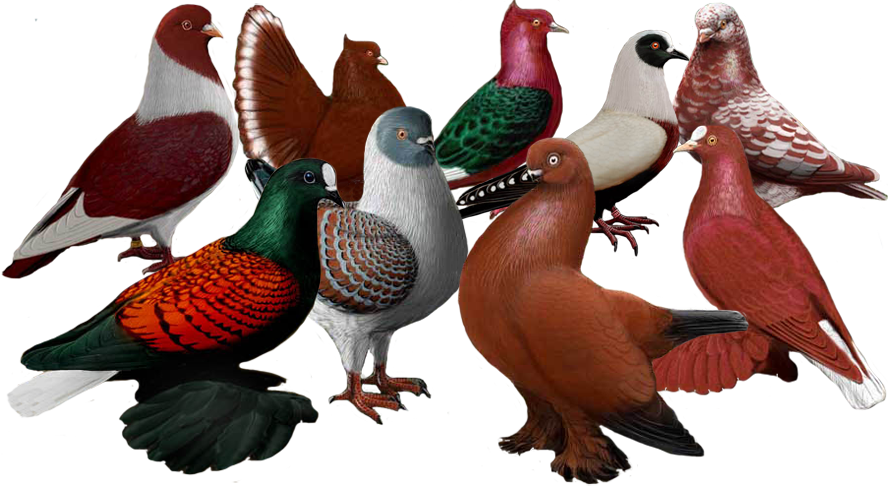
The black pigment that contributes to make the ash-red appearance has more or less red incorporated into the individual pigment granules. Thus, we see a variety of pigeon breeds presenting from almost white wing shield ash-reds to fairly bronzy ash-reds depending on the presence or absence of other mutants. In most ash-red hens, the mixture of black and ash-red pigment seems a bit lower overall concentration than normal in a cock bird and generally bronzier than in a cock bird. According to Dr. Richard Cryberg, when the bronze areas of feathers are examined under high enough magnitudes to see individual pigment particles, red and black particles are not visible. Instead, we are able to see dark particles with a reddish color. In a deposit of pigment we will see some particles blacker and some redder than the average. Depending on the amount of bronzing, the dark can be near black with just a reddish cast; or in a real red bronze, we can see near red but a darker cast than we see in the bar of an ash-red for instance. Dr. Cryberg concludes that it is clear from the work published on species other than pigeons that the pheomelanin and eumelanin are copolymers of each other, and to change color we simply change the ratio of ingredients.
Have you ever wondered why some bronze phenotypes closely resemble each other even though we know for a fact that they are not even alleles? Consider how much some homozygous recessive opals and homozygous indigos look like ash-red for example. We know that recessive opal comes in two different forms, the most recessive form of recessive opal looks very much like the ash-red or homozygous indigo. This form is named "cherry," which has red bars in the bar pattern, a very light colored tail, a negative tail bar, just like an ash-red. We know that ash-red, indigo, and recessive opal are not alleles but they do resemble each other as bronzes. Ash-red looks a great deal like cherry as does homozygous indigo. According Dr. Cryberg, both the ash red and indigo mutants produce some protein that somehow stops the wild-type gene at recessive opal from doing its normal function. Both ash-red and indigo might bind to DNA and prevent wild-type at recessive opal from being transcribed into protein. They could bind with the protein that wild-type at recessive opal produces and thus render the protein ineffective. They could refold the DNA again making it ineffective. They could bind with some starting material that the wild-type at recessive opal protein needs to do its job. Because indigo is co-dominant and ash-red is dominant, we do not know exactly what is going on with them, but we do know that ash-red and indigo mutants somehow stop the wild-type gene at recessive opal from doing its normal function. In addition, we now know that on a chemical level the same chemical pathway produces the pigment in every single one of the bronze phenotypes. So, all the bronze phenotypes in reality are just the result of decreased eumelanin (black and brown) pigments deposited into the feathers. All blue and brown pigeons have the same amount of red pigment (phenomelanin) as all bronzes do, but it is overwhelmed by the black or brown pigments.
The complexity of the kite and bronze phenotypes was first discussed and reported by Horlachers (1929). Horlachers states that the pattern produced by kite is very variable between the proportionate amounts of the red and black pigments. In some kite birds, the feathers are almost completely black with only a sprinkling of red; whereas, in others the color is largely red and there are all degrees of the mixture between these two extremes. In addition, Horlachers states that these varying degrees of mixture vary with regard to the portion of the pigeon on which it occurs. Horlachers reports his eight different observations about the kite:
1. Those which have kitiness in all their feathers.
2. Those which have kitiness in all their feathers excepting their tail
feathers.
3. Those which have kitiness in all their feathers excepting those on the
head and in the tail.
4. Those which have kitiness in the wing and back feathers only.
5. Those which have kitiness in the feathers on the wings and head only.
6. Those which have kitiness in the wing and tail feathers only.
7. Those which have kitiness in the wing feathers only.
8. Those which have kitiness in the primaries only.
I found the report of Horlachers on kite to be very confusing, but I have a feeling he worked with combination of different kites to get all these different results. The kite or the kites he was working with did seem to breed as a dominant, but because Harlachers fails to provide data about which kite he observed, and what other mutants were present on the birds he studied, today we have no clue how he got these results.
There are quite a few different phenotypes caused by combinations of different genes that give bronzing effect and they are all called "kite" among the pigeon fanciers. The weakest of them all does absolutely nothing but put some bronze on the primary flight feathers. We do not know if it is caused by heterozygous recessive red, but it is very common in American Modenas. According to Dr. Cryberg, this kite is also common in European Modenas but it is considered as a fault among European Modena breeders. Cryberg also states that this kite might enhance the patterns when combined with other Modena Bronzes. It is a simple autosomal dominant that affects both sides of the rachis, and it is probably the weakest kite among the rest of the kite phenotypes. In order to see it, one must actually unfold the wings and look for this kite, which will not be seen on the shield no matter what other mutants are present. The next one on the list of kites is the true kite. According to Quinn, pigmentations affected by the true kite, or the kite most commonly recognized among fanciers, is normally a T-pattern which shows bronzing in the inner webs of flight feathers. The area showing the most red pigment is in the transitional black to blue areas of the flight feathers, not including the tip. This kite is produced by a single autosomal dominant gene. It is not visible when the wings are folded; unfolding the wings of a kite bird will expose the trailing edges of the feathers. The true kite gives fairly nice bronzing on trailing edge of the primary flight feathers. When this kite is combined with a hetero recessive red on a T-pattern might give some bronzing on the shield. In addition, kite is completely masked by spread mutation. According to Quinn, the true kite is originally found in the colors of the English Short-Faced Tumbler and it seems parallel from Parlor and Oriental Rollers. The classical almond is the expression of almond on a kite base also. The affect of bronzing which the almond breeders call kite is more potent than the standard kite. The almond kite by itself will start to bronze up and get bronzier as the bird ages and darkens up. In addition to weak kite, true kite, and almond kite, we also have Modena bronze, Archangel bronze, Tippler bronze, Roller bronze, Brander bronze, Lebanon bronze, and Toy Stencil bronze. The pigeon breeders call all of these phenotypes kite as long as they see some bronzing in them and this is where the confusion comes from because we do not know which kite they are talking about. The only phenotype that is not called kite among breeders is the archangel bronze and/or when bronze is exclusively confined in to the pattern.
Quinn suggested that the family of bronzes can be classified, and they are assumed to be alleles where he tentatively symbolized them on the bases of kite (K). He did admit that these classifications were arbitrary and subject to change after more testing has been done, which may show that they were completely unrelated. However, he went on to assume they were alleles and assigned symbols to bronze phenotypes assuming they are located at the kite locus. While this may have been convenient in 1970, today we can be pretty sure most bronzes are not alleles. In his book, Quinn said,“For the purposes of the study, I have classified bronze phenotypes by the breed which characterizes them. There would be no way to analyze all these conditions, if we didn’t begin somewhere, and then proceed logically to test the matter” (The Pigeon Breeder’s Notebook, p. 75). We now know that bronze phenotypes are not a single allelic series, they are not mutually exclusive, and any bronze pigeon may be in possession of more than just one form of bronze. In addition, numerous secondary genes and polygenes enhance the phenotype of rich bronze coloring; hence the presence of recessive red seems to be an essential factor in some bronze phenotypes. Quinn classified the following breeds for their bronzing effect: Modena bronze (KM), Archangel bronze (KA), Tippler bronze (KT), Roller bronze (KR), Brander bronze (KB), Lebanon bronze (kl), and Toy Stencil bronze (KS). Let’s look at these bronzes that are supposedly specific to each breed:
MODENA BRONZE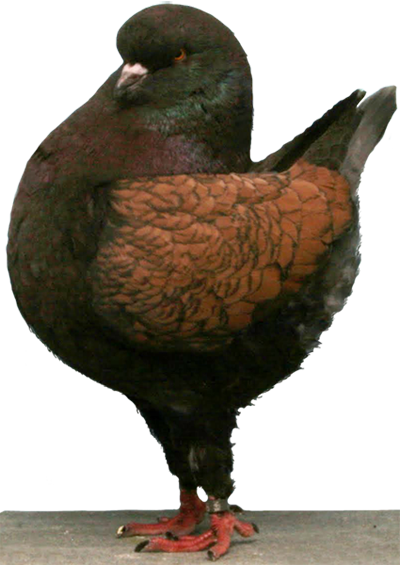
According to Quinn, Modena bronze affects primarily coarse spread areas of the shield, which is the main difference from other bronzes. The smooth spread and blue areas are affected little and appear normal on a wild-type phenotype. Spread and ash-red masks Modena bronze where the ash-red and black Modenas show no traces of the bronze characteristic of the breed. The inheritance of Modena bronze and isolation of the genes all together producing the Modena bronze phenotype was studied and well documented by Dr. Richard Cryberg in 2009. According to Cryberg, Modena bronze is a combination of three bronze mutants. One impacts the primary flights, and the other two both impact the coarse spread areas when present as heterozygotes. The former is dominant while the later two are fairly weak co-dominant or possibly even very nearly recessive, when by themselves. We can see them if we know what we are looking for, but otherwise we are likely to miss them. Cryberg reports that the combination of all three Modena bronzes as heterozygotes gives a bird with fair bronze coverage compared to good colored Modena bronzes. However this bronze is very muddy colored versus when the three are homozygous. The muted kite found in Modena bronze, which shows mainly on the webbing of the primary flight feathers and coverts, was named “Modena flight bronze” by Cryberg. Dr. Cryberg says, “Modena bronze is actually a misnomer. When all the needed genes are present as homozygotes the color is not bronze. Rather the pattern areas are red. Just as red as a recessive red that is also T-pattern, spread and dirty. It has none of the muddiness to the color seen in so many bronzes that include substantial amounts of black pigment. Very few of the Modenas seen today in the US show this good red color, as few Modenas are homozygous for all needed genes. Modena bronze affects mainly the pattern areas in the wing. On a check or T-pattern bird it should extend clear to the shoulder. On some birds it also extends to some minor extent into the head and tail feathers. These regions outside the pattern areas are never a good red like seen in the pattern. Rather they are a true bronze consisting of a mix of red and black pigment” ("Modena Bronze"). In the same article Cryberg also reports rather interesting information about Quinn spending five years to move Modena bronze into rollers but finally giving up the project because the bronzes produced were so poor. It baffles me why Quinn could not move the Modena bronze phenotype to a new breed in five years. Modena bronze have been successfully moved to many other pigeon breeds without any problems. Click on the following bronze Modena pictures to enlarge them.
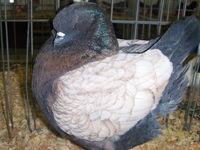 |
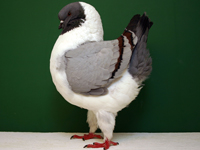 |
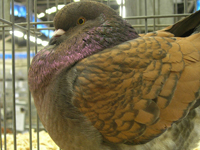 |
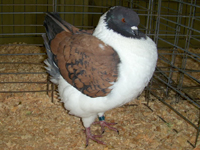 |
The first and fourth Modena bronze pictures directly above were taken from the http://www.backyardchickens.com/t/125438/pigeons-photos-from-the-show-in-stockton-ca-duw. The pictures were posted by nickname: theOEGBman and they were taken from 2009 show in Stockton, CA. DUW. The second picture (Modena bronze gazzi bar) was taken from NPA's website under "2009 Lancaster, PA Grand National Champions" section and the bird was bred by Jerry Burgr. The third picture was taken from the following website: http://mylittlebungalow.blogspot.com/2011/10/fair.html.
Because Dr. Cryberg, to this date, is the only person who produced data about Modena bronze genes, isolated all three Modena bronze genes, and made all three of them homozygous in different birds, I consider him as the most knowledgeable person when it comes to Modena bronze. He has seen how each of these genes looks when in the heterozygous state with no other bronzes present. He also said he had made two of these bronzes as homozygotes with no other bronzes present. So, over the phone I asked him to talk about the pictures that I have used in this article. You might think the single picture used above, right next to text is a classic Modena bronze, but according to Cryberg, it is not red enough; it is too brown. Cryberg says if you get a good Modena bronze and pull a feather out of the shield, and lay it next to a good recessive red, like the deep and rich color recessive red that we would normally see in West of England Tumblers, the color of the Modena bronze should be the same as that recessive red color. It is always possible the photo is not an accurate representation of what the bronze really looks like so it is hard to make a solid judgment. When we look at the phenotype of the first picture, which has very light toy stencil like wing shields, we can see why some breeders might confuse the Modena bronze phenotype with the toy stencil phenotype. Although colors might be distorted in the photo, it is also possible that this particular Modena might also been introduced to toy stencil genes if the owner thought he/she could enhanced the Modena color with TS genes. It is not uncommon nowadays to see many Modenas being hetero for so many other bronze genes and some of the TS genes are mixed in Modena breed at this point of time. Cryberg says he has seen some birds shown as Modena bronze but when examined closely he has seen none of the Modena bronzes that he has isolated in them; they were just very poor toy stencil. The second picture, bronze bar, can also be easily confused with the indigo. When I asked Cryberg to examine the bird from the picture, which he is not particularly fond of talking about the colors of birds from the photos, he said “I have to hold that bird in my hand to be sure, but from the picture it seems like it is hetero for one of the Modena bronze genes”. When I asked him, if he thinks that way because of the black edges seen in the bar section, he said the bronze itself at the bar area is not red enough and looks like there is too much black in the bronze. The third picture seems to be diluted version of the Modena bronze. Cryberg confirms that it is actually a nice representation of the Modena bronze dilute. When I asked him about the last gazzi Modena bronze picture he again said, “it is always hard to talk about a picture because we don’t know what the camera did to the color, but I think that bird's color is probably better than it looks in the picture. I would have to see the bird in my hand to be sure, but I would say that is a pretty decent Modena bronze” (private communication).
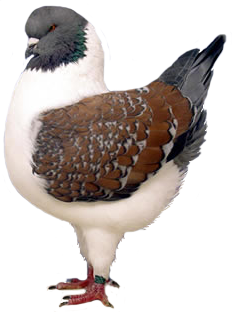 Dr. Sell informed me that
in Germany, the early literature describes the Modena pigeons
as “brown-bronze”,
but the breed standard from 1926 uses the word "copper" (Kupfer
in German). The same word is used to describe Copper-Gimpel
(Kupfergimpel in German). According to Dr. Sell, the standard
for German Modena requires
chestnut brown, not the rich red shields, which is expected
by the American Modena standards. Dr. Sell suggests that
because the rich
red Modena bronze is very hard to find even in USA as well
as in Germany, perhaps the real Modena bronze should be
considered as the chestnut
brown bronze in both places. Dr. Sell thinks the deep rich
red Modena bronze might be caused by the Modena bronze
plus some modifiers; perhaps
even allelic traits exist between the red and brown bronze
phenotypes. It is also possible that the rich red winged
birds are produced by
another gene combination. Lastly, Dr. Sell says the bronze
or sulfur primaries are considered a fault in German bronze
Modena and from his
understanding appear as a fault and a side effect in dark
checkered bronze pigeons. But, how should we take the findings
and standards
in Germany vs. USA? Perhaps here in US, we've bred away
from what the Germans had in the 20's and ended up creating
two different phenotypes
here and there. It is equally possible that it was the
Germans who changed things since the Modena as we know
it came to us from England
and is an English/American breed. In addition, it is possible
that we are comparing the Modeneser (the German Modena)
and the Modena as
we know it (English Modena) which is very different in
form and perhaps in some phenotypes. Ideally, birds from
the same family or family line
would be available to all breeders attempting to ascertain
which bronze we might be dealing with. So the best we can
usually hope for is that
we’re able to use the same breed, at least, and assume that the
gene pool for that breed, especially if it’s a long established
one, is fairly uniform in most things. This may be an invalid
assumption, but we have to start someplace. Since neither
Germans nor the Americans
using the same birds during experimental matings, it's
possible that there are "two" things going on, and both are
correct. The brown-bronze looking gazzi Modena picture
on the right is taken from this website: http://www.pigeonfanciers.ca/picture.html.
Dr. Sell informed me that
in Germany, the early literature describes the Modena pigeons
as “brown-bronze”,
but the breed standard from 1926 uses the word "copper" (Kupfer
in German). The same word is used to describe Copper-Gimpel
(Kupfergimpel in German). According to Dr. Sell, the standard
for German Modena requires
chestnut brown, not the rich red shields, which is expected
by the American Modena standards. Dr. Sell suggests that
because the rich
red Modena bronze is very hard to find even in USA as well
as in Germany, perhaps the real Modena bronze should be
considered as the chestnut
brown bronze in both places. Dr. Sell thinks the deep rich
red Modena bronze might be caused by the Modena bronze
plus some modifiers; perhaps
even allelic traits exist between the red and brown bronze
phenotypes. It is also possible that the rich red winged
birds are produced by
another gene combination. Lastly, Dr. Sell says the bronze
or sulfur primaries are considered a fault in German bronze
Modena and from his
understanding appear as a fault and a side effect in dark
checkered bronze pigeons. But, how should we take the findings
and standards
in Germany vs. USA? Perhaps here in US, we've bred away
from what the Germans had in the 20's and ended up creating
two different phenotypes
here and there. It is equally possible that it was the
Germans who changed things since the Modena as we know
it came to us from England
and is an English/American breed. In addition, it is possible
that we are comparing the Modeneser (the German Modena)
and the Modena as
we know it (English Modena) which is very different in
form and perhaps in some phenotypes. Ideally, birds from
the same family or family line
would be available to all breeders attempting to ascertain
which bronze we might be dealing with. So the best we can
usually hope for is that
we’re able to use the same breed, at least, and assume that the
gene pool for that breed, especially if it’s a long established
one, is fairly uniform in most things. This may be an invalid
assumption, but we have to start someplace. Since neither
Germans nor the Americans
using the same birds during experimental matings, it's
possible that there are "two" things going on, and both are
correct. The brown-bronze looking gazzi Modena picture
on the right is taken from this website: http://www.pigeonfanciers.ca/picture.html.
To further understand the difficulty of recognizing and sorting out the genes responsible for bronze phenotypes, we need to understand the history of them. For instance, in the late 1950s all Modenas were homozygous for all the Modena bronze genes, except Argents. Back then, breeders were careful about not mixing the colors, especially the breeds. According to Dr. Cryberg, when breeders mated an ash red to a blue, they were confident that they would get nice blue Modena bronzes from the mating:
“Argents were like a second breed. They never had the desired type of the bronzes. Argents were never mated to bronzes at that time as breed crossing was greatly looked down upon. Then roughly in the ’60s all of a sudden people started doing a lot of breed crosses to put new colors into established breeds, and breed crossing became something that could be admitted in polite company. Well, some people decided that a great way to improve the type of Argents would be to cross with bronzes. By the early ’80s the idea was widely presented that Modena bronze was simply part of toy stencil. So, the idea was to cross an Argent to Modena bronze, take the F1’s and either mate them together or mate them back to Argent and you could dirt easy recover the toy stencil and get better type. After all, you only had a one or two gene difference between Modena bronze and toy stencil, so recovery of toy stencil would be dirt easy. From a back cross to Argent for instance if there was a two gene difference one young in four would be excellent toy stencil. Well, the idea was a great idea if the hypothesis on them sharing common genes was right. But when people tried this game it did not work. An F1 mated back to Argent gave you no good Argents. In fact it took two or three back crosses to Argent to get back to reasonable toy stencil phenotypes according to people I have talked to that made these attempts. People I have talked to said what they observed was it took so many back crosses that by the time you got back good toy stencil you had lost all the type you had tried to introduce with the cross to bronzes. In fact it was such reports that first induced me to take a look at Modena bronze. But, there were also other reasons I took that look. For instance Joe Quinn, and several others told me of their efforts to move Modena bronze into Rollers or Homers or other breeds. And after several years of effort, in Joe's case five years, they all gave up in frustration as they had nothing even close to half decent Modena bronze phenotypes. As the claim was Modena bronze was a single dominant gene, it should have been dirt easy! Yet, they failed totally. In fact some said they saw very little or no bronze in the F1s. So, how can it be a dominant?” (R. Cryberg, private communication).
I am pretty sure the history told by Cryberg about Modenas can easily be told by other breeds as well, which would explain why sorting out the bronze genes would be even more difficult because breeders in the past mixed them all together. I have some Rollers bred by Dal Stone for instance. I must admit Dal Stone makes some beautiful birds, but from the scientific standpoint, most of these birds are useless because they were all mixed together, especially the toy stencil and frill stencil. A lot of people out there are still confusing the phenotype difference between the toy stencil and frill stencil and many of them are convinced that the toy stencil is part of the frill stencil. I have bred a frill stencil and toy stencil from the same parents of Dal Stone Rollers for instance, but not because toy stencil (TS) and frill stencils (FS) are related. It’s simply because they were mixed in by breeders thinking they are part of each other and problems like these would make isolating TS and FS genes almost impossible. It should be noted that the similarity in the expression does not mean automatically an identical genetic code or allelic relation. Dr. Axel Sell also agrees with the difficulty of sorting out the bronze genes and properly identifying and naming the bronze phenotypes:
“Fanciers freely mix the different types: Brander were crossed with Netherland Highfliers, Netherland Highfliers with Show Tipplers, Berlin Short Beaked Copper Tumblers with Show Tipplers and English Short Faced kites and agates, etc. Thus the genetic constitutions change over time, and it is hard to decide what is required for a specific phenotype and which genes are present just by accident because of a former cross with other breeds or colorations. For dominant genes the F1 of a mating of two similar phenotypes will not tell us much, also the backcross is not helpful to decide whether both traits are identical, allelic or nothing of both. Even the F2 might not give a clear picture because of classification problems, disturbing enablers, masking effect, the popping out of hidden recessive traits, etc. The discussion of the different traits is complicated by the vague terminology in the fancy and the different meaning of Kite for the fanciers. However, there is also no consensus on when to speak of a polygene expression and when of modifiers, and also other terms are used in different meaning. Often controversies do not have their reason in the matter but in different terms used,” says Dr. Sell (private communication).
BRANDER BRONZE
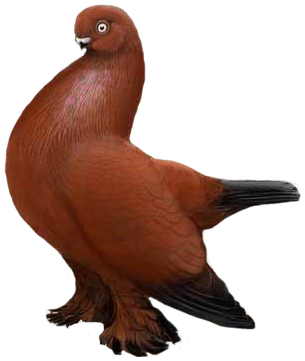 Brander
bronze looks very much like the very rich and bronzy
version of recessive red. In addition to the bronzy red all over
the body, the Brander bronze
also has primary and secondary flights tipped with solid black color
and the tail shows a distinct solid black bar. This is the original
Brander bronze phenotype that comes from the Copenhagen Tumbler (Fire
Pigeon). This phenotype is also very common in Dutch Highfliers and
the Show Tipplers. The Stettin Tumbler and the Berlin Short Faced Tumbler
have also very similar Brander bronze phenotype except instead of having
just the tip of the primary flights and the tip of the tail being black,
they have these feathers in complete black colors. Brander phenotypes
can be made multiple different ways. Several anecdotal reports from
breeders suggest that Brander
bronze is produced by combination kite, recessive red and T-pattern
check. However, it seems these three genes may not be sufficient to
make a Brander
bronze; otherwise, we would have brander phenotypes in all kinds
of breeds. According to Dr. Cryberg, there are three possible ways
to make Brander
bronze phenotypes. True Brander is very rich bronze that is homozygous
for some bronze, but no one knows which one. We only presume that
it is not the Tippler bronze or the kite. It is also T-pattern and
has recessive
red in either heterozygous or homozygous state. It is obvious that
Brander bronze also has some darkeners, possibly dirty, but we do not
know which
darkener that is. Mating true Bronze phenotypes together gives 100%
Branders. However, some of these Branders have only minor black bars
in the tails
and only minor black ends on the primary flights. These birds with
only minor black are homozygous recessive reds. The other way to get
a Brander
bronze is a combination of homozygous Tippler bronze, heterozygous
recessive red, and T-pattern plus some darkeners. Mating these birds
together will
give some excellent reds and some Tippler bronzes as well as 50%
Branders. Another way a Brander bronze can be made is a combination
of kite bronze,
Modena bronze and hetero recessive red on a T-pattern with some misc
darkeners thrown in can give a fair Brander phenotype. In this case
the darkeners
are nothing particularly special. The normal dirties that turn a
blue to a good grungy dark blue like you find in Homers or Rollers
is adequate.
Brander
bronze looks very much like the very rich and bronzy
version of recessive red. In addition to the bronzy red all over
the body, the Brander bronze
also has primary and secondary flights tipped with solid black color
and the tail shows a distinct solid black bar. This is the original
Brander bronze phenotype that comes from the Copenhagen Tumbler (Fire
Pigeon). This phenotype is also very common in Dutch Highfliers and
the Show Tipplers. The Stettin Tumbler and the Berlin Short Faced Tumbler
have also very similar Brander bronze phenotype except instead of having
just the tip of the primary flights and the tip of the tail being black,
they have these feathers in complete black colors. Brander phenotypes
can be made multiple different ways. Several anecdotal reports from
breeders suggest that Brander
bronze is produced by combination kite, recessive red and T-pattern
check. However, it seems these three genes may not be sufficient to
make a Brander
bronze; otherwise, we would have brander phenotypes in all kinds
of breeds. According to Dr. Cryberg, there are three possible ways
to make Brander
bronze phenotypes. True Brander is very rich bronze that is homozygous
for some bronze, but no one knows which one. We only presume that
it is not the Tippler bronze or the kite. It is also T-pattern and
has recessive
red in either heterozygous or homozygous state. It is obvious that
Brander bronze also has some darkeners, possibly dirty, but we do not
know which
darkener that is. Mating true Bronze phenotypes together gives 100%
Branders. However, some of these Branders have only minor black bars
in the tails
and only minor black ends on the primary flights. These birds with
only minor black are homozygous recessive reds. The other way to get
a Brander
bronze is a combination of homozygous Tippler bronze, heterozygous
recessive red, and T-pattern plus some darkeners. Mating these birds
together will
give some excellent reds and some Tippler bronzes as well as 50%
Branders. Another way a Brander bronze can be made is a combination
of kite bronze,
Modena bronze and hetero recessive red on a T-pattern with some misc
darkeners thrown in can give a fair Brander phenotype. In this case
the darkeners
are nothing particularly special. The normal dirties that turn a
blue to a good grungy dark blue like you find in Homers or Rollers
is adequate.
According to Quinn, Brander bronze resembles Tippler bronze in many ways, where they both show some red in the tips of the flights. Spread suppresses the Tippler version, but some evidence exists that many Branders are actually spread. Unlike Tippler bronze, the Brander bronze does not revert to the “gay pied” expression which is very common in Tipper bronze. According to Sell, the effect of Brander bronze differs in several breeds which will be caused by modifying factors. “The Danish Brander are near to solid bronze with a black tail bar and black tips of the wing flights. The inner parts of the flights remain bronze, however. In the Berlin Copper Tumbler the wing feathers, the foot-feathering and the tail are blue-black, the tail bar mostly a shade darker. ‘Light Brander’ is tigered Danish Brander. This is true also for the bronze of some Tumblers from East and South Europe (Gibson, 5:3). In some of these breeds modifications are caused by grizzle and pied factors not yet analyzed in sufficient manner. Combined with dilution again sulphur is produced,” says Axel Sell (Breeding and inheritance in pigeons, p. 110). Unlike Quinn, Sell suggests that spread is not one of the mutant genes of the Brander bronze. Sell states that the common genetic basis of the different Brander bronze is caused by dark checker pattern, heterozygous or homozygous recessive red. Sell also reports that the evidence of recessive red being one of the mutants of Brander bronze phenotype was reported by Klein (1920) on Standard Berlin Copper Tumbler.
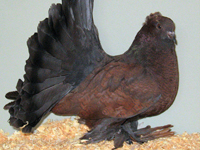 |
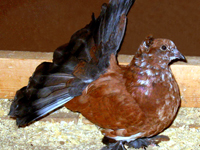 |
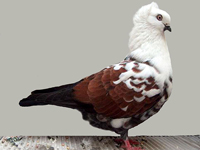 |
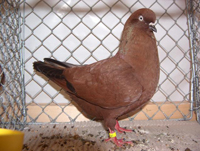 |
The first and second Brander bronze pictures above were provided by Lynn Kral, who has been breeding Brander bronzes for quite some time now. Kral informed me that without recessive red being present in the genotype, Brander phenotype cannot be established. Several anecdotal reports from other breeders suggest that under grizzle might be part of the Brander bronze phenotype but Kral states she hasn’t noticed any under grizzle in her Brander bronzes but that does not mean it is part of the genotype and masked by the bronze. Mrs. Kral’s experience also suggests that when grizzle is present in a Brander phenotype, the color seems to stay bright even after the adult molt. While the Brander bronze on a kite bird will not be as bright and as pretty after the adult molt. Kral also shared her experience of using the kite from the Brander bronze in almond breeding. “I have noticed that when you use a Brander Bronze Kite in Almond breeding the break seems like it does not break through and show very much and the birds do not seem to increase in getting very much more break each year after molting. The ground color is much more rich on an Almond with brander bronze in it, but there is a loss in the amount of break the bird would show”, says Lynn Kral (private communication). The third picture - Timisoara Tumbler, was taken from the Encyclopedia of Pigeon Breeds website http://pigeon-kingdom.blogspot.com/2010/04/timisoara-tumbler-pigeon-pellumb.html. Finally, the last picture - Dutch High Flyer was also taken from the Encyclopedia of Pigeon Breeds website http://pigeon-kingdom.blogspot.com/2010/04/dutch-high-flyer-pigeon-holenderski.html.
TIPPLER BRONZE
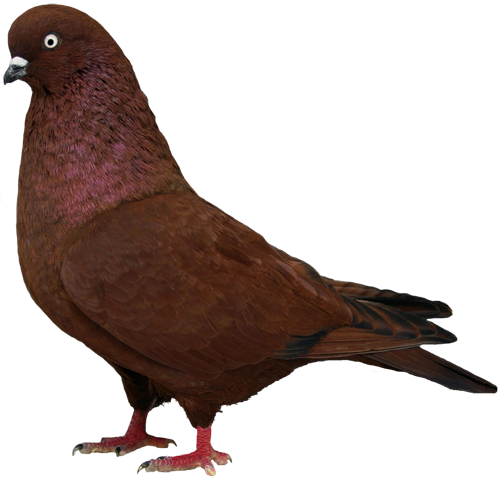 Tippler
bronze has a close association with grizzle
which suggests possible linkage. Quinn points out that when Tippler
Bronze is mated to wild-type, they produce all forms of grizzles
and pied combinations. Tippler Bronze affects coarse spread pigment,
and to a degree, the blue areas, and it is often confused with Brander
bronze because of their similar phenotypic affects. According to
Quinn,
Spread mutation suppresses the tippler bronze but does not completely
mask it, where
they will show a high degree of bronzing. Quinn also points out
an interesting phenomenon about why two breeds
that have the
common ancestry, Rollers and Tipplers, should have different expressions
of bronzes. It is possible that the Roller bronze, which is not as
common as the
Tippler bronze, might lack some genes or might have additional genes
compared to Tippler bronze to get a distinct bronze phenotype. Although
we don’t have any data about the Tippler bronze, we do know
that the Tippler bronze phenotype – copper/chestnut color with
black tips to flights and a black tail bar is not the result of a
single gene, but rather a complex grouping of numerous genes. Among
the Tippler breeders, it is accepted that the following mutant genes
are part of the Show Tippler genotype: T-pattern check, recessive
red,
kite and whatever the bronze gene is found in Tipplers. There is
big difference between show tippler bronze and the majority of other
bronzes. The Show Tippler has been perfected to the highest degree
and has
a tail of rich chocolate brown color with a distinct black bar, whereas
other breeds have a blue black tail with a darker bar, which is definitely
not accepted by the Show Tippler breeders. In the Show Tippler, the
basic color is a rich chocolate/chestnut brown (not dissimilar to
a deep recessive red color) with a rich metallic mauve/pink sheen,
the primary and secondary flights have a clearly defined solid black
tip, and the tail shows a distinct solid black bar; any "dusting"
of black coloration is a definite fault. The Show Tippler picture
used here taken from NPA's website - Breeder: Dan Brennan. Show
Tippler bronze pictures below taken by Arif Mumtaz.
Tippler
bronze has a close association with grizzle
which suggests possible linkage. Quinn points out that when Tippler
Bronze is mated to wild-type, they produce all forms of grizzles
and pied combinations. Tippler Bronze affects coarse spread pigment,
and to a degree, the blue areas, and it is often confused with Brander
bronze because of their similar phenotypic affects. According to
Quinn,
Spread mutation suppresses the tippler bronze but does not completely
mask it, where
they will show a high degree of bronzing. Quinn also points out
an interesting phenomenon about why two breeds
that have the
common ancestry, Rollers and Tipplers, should have different expressions
of bronzes. It is possible that the Roller bronze, which is not as
common as the
Tippler bronze, might lack some genes or might have additional genes
compared to Tippler bronze to get a distinct bronze phenotype. Although
we don’t have any data about the Tippler bronze, we do know
that the Tippler bronze phenotype – copper/chestnut color with
black tips to flights and a black tail bar is not the result of a
single gene, but rather a complex grouping of numerous genes. Among
the Tippler breeders, it is accepted that the following mutant genes
are part of the Show Tippler genotype: T-pattern check, recessive
red,
kite and whatever the bronze gene is found in Tipplers. There is
big difference between show tippler bronze and the majority of other
bronzes. The Show Tippler has been perfected to the highest degree
and has
a tail of rich chocolate brown color with a distinct black bar, whereas
other breeds have a blue black tail with a darker bar, which is definitely
not accepted by the Show Tippler breeders. In the Show Tippler, the
basic color is a rich chocolate/chestnut brown (not dissimilar to
a deep recessive red color) with a rich metallic mauve/pink sheen,
the primary and secondary flights have a clearly defined solid black
tip, and the tail shows a distinct solid black bar; any "dusting"
of black coloration is a definite fault. The Show Tippler picture
used here taken from NPA's website - Breeder: Dan Brennan. Show
Tippler bronze pictures below taken by Arif Mumtaz.
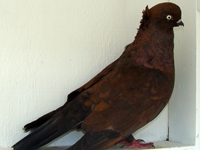 |
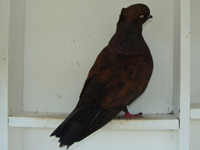 |
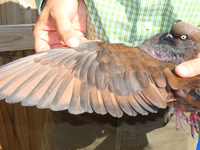 |
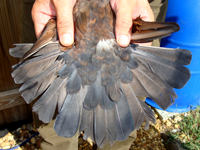 |
ROLLER BRONZE
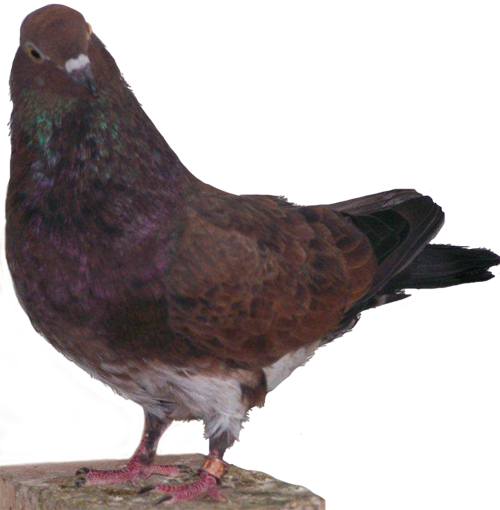 The
only description of Roller bronze that
we know of appears in Joseph W. Quinn's The
Pigeon Breeder’s Notebook. Quinn states that the Roller
Bronze is a weak form of bronzing in both coarse and smooth spread
areas,
and has very little effect on the blue areas. It is a simple autosomal
dominant gene where it has tendency to increase the expression
of bronze in smooth spread areas on ash-red birds. Quinn wrote, “Roller
bronze is a weakly expressed mutant. It is difficult to increase
or decrease the amount of red by selection. The bronze of Rollers
responds very slowly to modification. It took nearly sixty years
of rigorous selection to develop phenotypes that approach the bronze
kite of Tumblers for use in almond Roller matings. To the extent
that kite (K) can easily ‘graded-up’ in Rollers. I
have given Roller bronze a separate classification. Spread (S)
is epistatic to Roller bronze (KR)” (The
Pigeon Breeder’s Notebook, p. 77). Quinn also states
that the bronze of Rollers were imported into the United States
from 1860-1910
along with later imports of Tippler bronze. However, the description
of Roller bronze is so vague we have no clue how it behaves and
we know of zero data on its inheritance. So, this brings up an
important question: Does Roller bronze really exists? There are
several reasons why I am questioning the existence of the Roller
bronze. First of all, we know that Tipplers came from Rollers that
did not roll. So, if there is or there are bronze genes in one
breed, we would expect to see the same bronze in both. Secondly,
we have zero data about Roller bronze other than the poorly written
description by Quinn. So, even if a separate bronze gene does exists
in Rollers, more than likely we will not know how it looks like.
Rollers sure come with variety of bronze phenotypes, just as many
other pigeon breeds; but, that does not necessarily mean they are
in fact the Roller bronze Quinn was talking about. Since the definition
of bronze and the phenotypes produced by bronze
genes are pretty wide, it would be very difficult to prove and
disprove if Roller bronze does exists. All
the bronze Roller pictures used in this section were bred and provided
by Gregg Sale.
The
only description of Roller bronze that
we know of appears in Joseph W. Quinn's The
Pigeon Breeder’s Notebook. Quinn states that the Roller
Bronze is a weak form of bronzing in both coarse and smooth spread
areas,
and has very little effect on the blue areas. It is a simple autosomal
dominant gene where it has tendency to increase the expression
of bronze in smooth spread areas on ash-red birds. Quinn wrote, “Roller
bronze is a weakly expressed mutant. It is difficult to increase
or decrease the amount of red by selection. The bronze of Rollers
responds very slowly to modification. It took nearly sixty years
of rigorous selection to develop phenotypes that approach the bronze
kite of Tumblers for use in almond Roller matings. To the extent
that kite (K) can easily ‘graded-up’ in Rollers. I
have given Roller bronze a separate classification. Spread (S)
is epistatic to Roller bronze (KR)” (The
Pigeon Breeder’s Notebook, p. 77). Quinn also states
that the bronze of Rollers were imported into the United States
from 1860-1910
along with later imports of Tippler bronze. However, the description
of Roller bronze is so vague we have no clue how it behaves and
we know of zero data on its inheritance. So, this brings up an
important question: Does Roller bronze really exists? There are
several reasons why I am questioning the existence of the Roller
bronze. First of all, we know that Tipplers came from Rollers that
did not roll. So, if there is or there are bronze genes in one
breed, we would expect to see the same bronze in both. Secondly,
we have zero data about Roller bronze other than the poorly written
description by Quinn. So, even if a separate bronze gene does exists
in Rollers, more than likely we will not know how it looks like.
Rollers sure come with variety of bronze phenotypes, just as many
other pigeon breeds; but, that does not necessarily mean they are
in fact the Roller bronze Quinn was talking about. Since the definition
of bronze and the phenotypes produced by bronze
genes are pretty wide, it would be very difficult to prove and
disprove if Roller bronze does exists. All
the bronze Roller pictures used in this section were bred and provided
by Gregg Sale.
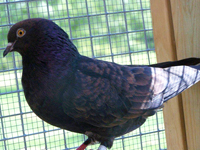 |
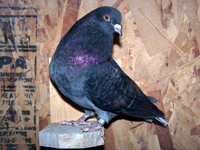 |
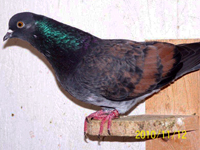 |
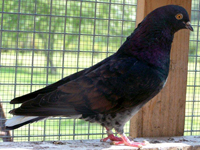 |
LEBANON BRONZE
Lebanon bronze is known to produce ribbon-tail phenotypes when combined with ash-red, T-check, and dirty, but likely some other bronzes besides Lebanon will also work to give at least reasonable ribbon-tail phenotypes. In addition, it is clearly visible for some indigo phenotypes to show somewhat mimics of ribbon-tail, both in the basal parts of the tail and flight feathers. Lebanon may or may not be the same as Tippler bronze. No one can be sure as no tests have been done except some anecdotal reports from the breeders. According to Franklin D. Albertsen, his unpublished breeding data indicates that Lebanon bronze is due to two recessive bronzes, and one of them is just like the recessive bronze we found on Gimpel's (Archangel) head and neck. The other recessive is what adds that good bronzing on the basal parts of the flight and tail feathers, and without this gene, we would not get that deep blood red Lebanon ribbon-tail where they express best on ash-red. Albertsen says when a ribbon-tail phenotype is produced by Lebanon bronze and when it is diluted, paled or faded, it seems the inner vanes shows pigments and not the clear washed out whitish appearance. The ribbon-tail roller picture used below has been bred by myself whose parents originally came from Dal Stone.
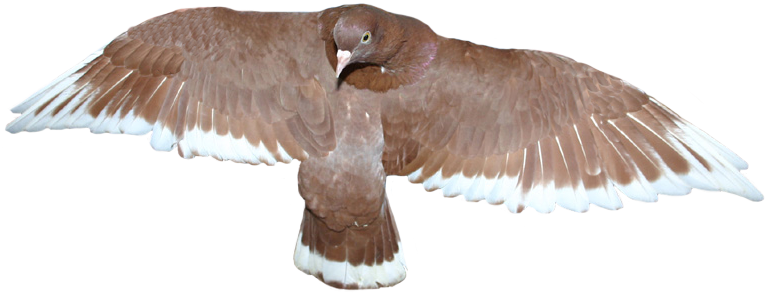
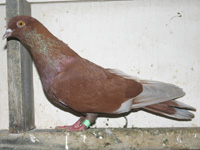 |
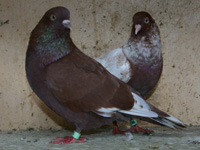 |
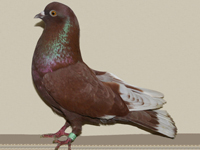 |
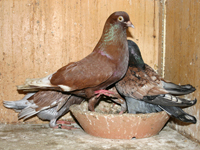 |
Interestingly enough, Quinn
classified Lebanon bronze as the only recessive bronze compared to
other bronzes found in other breeds. He reported that when Lebanon
bronze is mated to wild-type, all the F1 will be wild-type indicating
recessiveness. Quinn says the inheritance of Lebanon bronze has only
been studied in matings of Shikli Ahmar red, which is an ash-red T-pattern
check. So, if the Lebanon bronze that Quinn tested was an ash-red,
T-check and whatever the bronze gene(s) is in Lebonan bronze, then
how come the F1 gave wild-type result since ash-red is dominant to
wild-type? The only possible answer is, if all the Shikli Ahmar crosses
Quinn used were hens, but I highly doubt Quinn would come to this conclusion
knowing ash-red is sex-linked. Because Quinn fails to provide any breeding
data for this claim, I personally do not understand how he got wild-type
in F1. Perhaps Quinn was referring to the bronze gene found in Lebanon
bronze by itself being recessive to wild-type. However, even if that
was the case, then I can only partially agree with him. I say “partially” because
in my experience, mating Lebanon bronze to wild-type gave T-check ash-reds
where the basal part of the wings still showed ribbons. However, the
color of the ribbon changed from white to ash. More importantly, the
tail still showed some ribbon that was about 80% to 90% less visible
ribbon; again changing the color of the ribbon from white to ash showing
distinct phenotypic tail from an average ash-red tail. My experience
leads me to believe that the bronze gene or the genes found in Lebanon
bronze are either recessive or weak co-dominant, and mainly lost when
crossed with wild-type. The ribbon becomes visible when bronze is present
in the genotype and becomes completely white when all the bronzes are
present at the homozygous state. Since we do not have any published
data other than Albertsen’s unpublished breeding results, we
really do not know how many bronze genes there are in the Lebanon bronze.
In addition, in my experience, there seems to be a sex distinction
between male and female ribbon-tails. Hens, unlike males often show
ashy color ribbons instead of the white ribbons. I think
the ashy vs. white ribbon different might be the result of whether
the bird is homozygous or hemizygous for the sex-linked ash-red mutant.
The above ribbon-tail, Lebanon bronzes were all bred by me. Notice
the
ashy ribbons of the hen in the first picture compared to the white
ribbons on the rest of the ribbon-tails. Also notice the ashy ribbon
in F1 on the last picture when Lebanon bronze was mated to toy stencil.
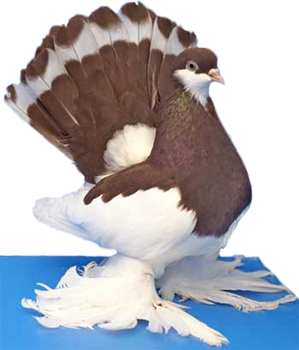
The Volga Tumbler picture on the left is taken from: http://www.kalbapigeon.com. It is an ancient breed originated in Siberia with rich and old history that almost disappeared in WW2. The white edges produced by the bronze phenotype are called the startails in this breed, as we call the similar phenotype ribbon-tail from the Lebanon breed called the Shikli Ahmar. We have no data to suggest if the startail phenotype found in Volga tumblers are produced by same genes or allelic genes to produce the ribbon-tail phenotype. Dr. Axel Sell shared his own experience with me on Lebenan bronze:
“I have some experiences with Lebanon-Bronze in Rshew Startail Tumblers and Volga Tumblers, not with Lebanon Pigeons. The Startail trait is not restricted to the intense red of these breeds. I got the phenotype in Racing Homers, I had it in Russian Highfliers and I saw it in stocks of German Beauty Homers. All of them had a more or less weak red color. Therefore, I suspect: no bronze, no smoky, no sooty, no dirty, nothing of the ingredients supposed in literature helpful or even necessary in creating the Startails. If Lebanon-Bronze exists it is color-deepening. Lebanon-Bronze may be helpful to intensify color and thus to get a contrast to the white tail bar, it seems to have nothing to do with the white tail bar itself. The intense color and the tail bar is lost in the first generation and established in some young of the backcross. A bronze trait was present in the Volga Tumbler used in the breeding pen and was documented at a dark F2 hen (black pigmentation). I do not know what Quinn investigated, but if we consider a trait that only shows at a dominant red basis like the startail-bar, a dominant red lacking this trait might serve as wild-type. If Quinn was interested to see what happens with glance in the F1 at a blue-dark check he could have mated a blue bar or blue check of another breed to a Lebanon hen to study the blue dark F1-hens. But I really do not know what Quinn did and what he had in mind,” says Dr. Sell (private communication).
It is imperative to understand that the phenotype we call ribbontail, which is found in Shikli Ahmar, and Asmar, or the startail phenotype, which is found in Rshew Startail Tumblers and Volga Tumblers, should not be the only phenotypes where Lebanon bronze is expressed, if in fact there is a so-called Lebanon bronze gene(s). We presume Lebanon bronze is best expressed on T-check ash-red plus a darkener – possibly sooty or dirty. However, since no one has identified and isolated the individual bronze gene(s) in Lebanon bronze yet, and no one has demonstrated how they would look like on wild-type in heterozygous and homozygous state, it is reasonable to argue that at this point we still do not know a whole lot about the Lebanon bronze and it’s inheritance. It is not hard to guess that Quinn didn’t know much about the bronze genes, but he also knew very well that all the bronzes he listed were not all alleles. He simply hoped by presenting the idea maybe someone would do some testing of his hypothesis and prove him wrong, but it seems no one was able to prove or disprove Quinn’s theory on bronze genes, just yet.
ARCHANGEL BRONZE 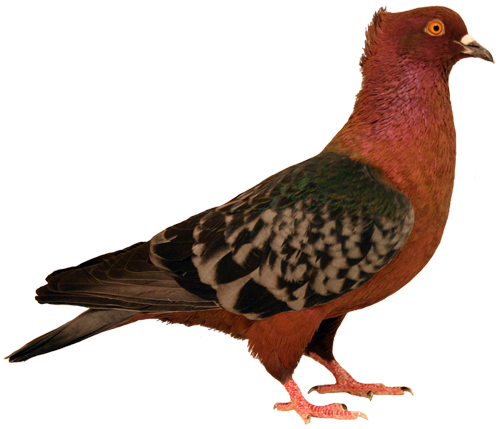
The Archangel bronze has a very unique pattern; it is nearly the reverse expression of Modena bronze; thus, the coarse spread areas and the smooth spread areas of the Archangels are near normal. In other words, the normal color of the bird is only visible at some portions of the body. Head, neck, breast, belly shanks and under-tail wedge are to be Archangel bronze; and wings, back, rump and tail are to be normal colors. This pattern in show types are nearly perfect where the demarcation between the bronze and the other portions should be clearly separated by a line where the hackle meets the shoulders. In adition, when the wing is opened there should be a rich chestnut color across the inner webbing. The bronze portion of the Archangel tends to vary from a sandy bronze to a dark copper, the ideal color being approximately mid-way between the two a bright copper bronze. The wing shield color and pattern can be any possible combinations of color & pattern that we would normally expect to see in Columba livia domestica, except the epistatic genes like recessive red, recessive white, spread, and albino. These genes will mask the entire body. Other than allowed in white flights, monk marked or priest marked varieties, the white feathers in any area are considered to be faults. The most significant feature of the Archangel is the abundance of metallic luster over the plumage, thus rendering colorful parts of the plumage that would otherwise appear to be dull. The Archangel breed is also known as the Gimpel, which is German for European Bullfinch. In Great Britain only the black and copper colored birds are called Archangels, but in the USA all color forms are referred to as Archangels. The blue check Archangel picture used here was taken from NPA's website and Bred by Carl Spece.
According to Horlachers (1929) report, some archangels show only a very slight bronze flecking. In these the flecking is in the inner vanes of the primaries and is not visible when the wings are folded. Others show more flecking in various amounts. In some there is sufficient bronze in the wings to give them a decided reddish cast. Horlachers (1929) also states that there are two types of Archangels, known as the dark bronze and the light bronze. These differ with regard to the shade of the bronze. The bronze on the dark bronze Archangel has a rich copper color, while the bronze on the light bronze is golden yellow. Quinn (1971) reported that mating Archangel bronze to wild-type produced offspring with slight bronzing in the blue areas showing dominance to wild-type. According to Axel Sell, the early tests of the Archangel bronze inheritance indicated dominance by Bessmertnaya (1928) and Jan Metzelaar (1926). Sell also states that Horlacher in 1929 was misdirected by believing that the bronze produced in Archangels was produced with the help of the spread gene. In his report Horlacher concluded that mating bronze Archangels with spread black gave spread F1. Because Horlacher did not realize that dark bronze Archangels were mimicking spread but they were genetically checkers with darkening factors, he concluded that the Archangel bronze phenotype was caused by two recessive genes. Since our current understanding proves that spread is not involved in the Archangel bronze’s phenotype, the correct testing by Horlachers should have been done against blue bars or blue checks. Thanks to Dr. Sell’s studies, we now know a lot about the inheritance of the Archangel bronze, but Dr. Sell admits that there is still a lot to clear up to get a better understanding of the Archangel bronze. This is what Sell said in his book that he wrote in 1994:
“Archangel Bronze affects primarily blue areas of the body including head and neck. The wings and the tail are not changed by this gene. Matings with wild-type produce offspring with some bronze in the otherwise blue areas of the body. Such crosses with blue bars will also indicate that the black wings of the Archangel are not the result of S (Spread). Dark bronze Archangels are of a dark checker pattern and carry some further modifying factors which bring about the deep and intense coloration. Some Bronze Archangels are also heterozygous for recessive red, e +, as demonstrated by occasional appearance of some self-red young, or in the case of the Light bronze or Gold Archangels by some self-gold young. The gold Archangel is diluted by the pale factor. The white-wing Archangels are of ash-red ground colour, and thus can be looked upon as mealy barless or mealy bars which carry the Archangel Bronze. In addition Lebanon Bronze might be present,” says Axel Sell (Breeding and inheritance in pigeons, p. 109).
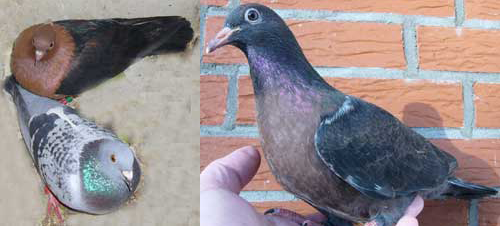 In
2011, at his website, Axel Sell reported his new findings on the inheritance
of Archangel bronze genes. Sell stated that according to his
tests, the Archangel bronze phenotype produced by mainly a dominant
trait responsible for the body-coloration,
plus a recessive trait, responsible for the head, which regularly appears
in some offspring in the F2. Sell also suggested that several additional
modifiers seem to be at work as well for the Archangel bronze. Sell concluded
that both traits, dominant and recessive bronzes that he isolated in
Archangel bronze, act
together to produce the typical gimpel-coloration with the contrast
of wing and
tail color
and the remaining plumage. Because Axel Sell's breeding data clearly
indicates that Archangel bronze is not allelic to kite as Quinn suggested
in 1971,
Sell assigned a new symbol Ka1 for the dominant
trait and ka2 for the recessive
trait found in Archangel bronze, and concluded that these two traits are
also not allelic to each other.
In
2011, at his website, Axel Sell reported his new findings on the inheritance
of Archangel bronze genes. Sell stated that according to his
tests, the Archangel bronze phenotype produced by mainly a dominant
trait responsible for the body-coloration,
plus a recessive trait, responsible for the head, which regularly appears
in some offspring in the F2. Sell also suggested that several additional
modifiers seem to be at work as well for the Archangel bronze. Sell concluded
that both traits, dominant and recessive bronzes that he isolated in
Archangel bronze, act
together to produce the typical gimpel-coloration with the contrast
of wing and
tail color
and the remaining plumage. Because Axel Sell's breeding data clearly
indicates that Archangel bronze is not allelic to kite as Quinn suggested
in 1971,
Sell assigned a new symbol Ka1 for the dominant
trait and ka2 for the recessive
trait found in Archangel bronze, and concluded that these two traits are
also not allelic to each other.
The pictures above show copper black wing Archangel mated to Blue Check Homer, and one of the F1 produced from this mating is taken from Axel Sell’s website with his permission. In F1, we can clearly see the dominant Ka1 bronze showing bronze in heterozygous state from the neck down, while the recessive gene ka2 giving bronze color to the head was hidden by the wild-type.
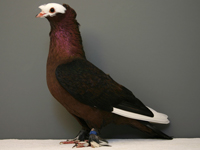 |
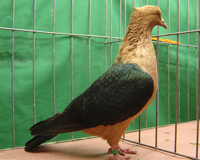 |
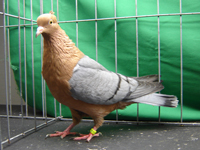 |
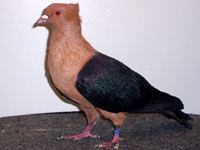 |
The first Archangel bronze picture used above was taken from NPA's website under "2009 Lancaster, PA Grand National Champions" section and the bird was bred by Harold Jones. The second and third pictures were taken from the American Archangel Club’s website. The second picture was Des Moines Champion and the third picture was Des Moines Reserve Champion both bred by Kerry Hendricks. The fourth picture was taken from the Vancouver Poultry & Fancy Pigeon Association website under Winter Show 2010 section. The bird was bred by Casey & Jerry.
TOY STENCIL BRONZE
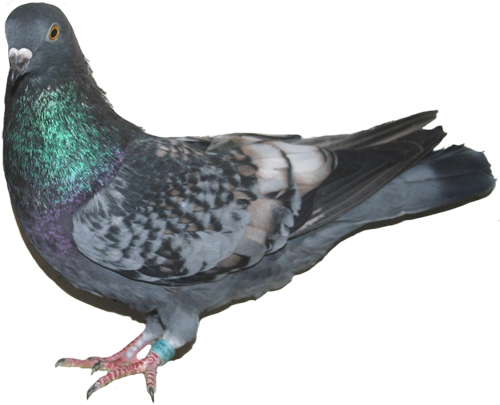 According
to data provided by Joe Quinn, toy stencil is a phenotype produced
by three co-dominant genes. Seemingly, any combination of these
three genes produces toy stencil bronzed
birds that never have the bronze turn into the white unless all
three genes are in the gene pool
in homozygous state. When toy stencil is mated to wild-type, the
F1 always produces some sort of bronze especially in the pattern
area of the shield. In addition, it seems there is more than one
group of genes called toy stencil because some breeds take three
or four years to get white from bronzy phenotype while other breeds
clean up and turn bronze into white at the first molt. Furthermore,
because some incomplete versions of toy stencil phenotype mimic
the phenotype of Modena bronze, some fanciers think the genes producing
Modena bronze phenotype are part of toy stencil phenotype. According
to Dr. Cryberg, these claims are pure nonsense because the heterozygous
bronzes we get from the various mutants that produce Modena bronze
look nothing at all like the heterozygous bronzes we get from toy
stencil: “In fact the Argent Modena breeders have all known
for many years that toy stencil and Modena bronze were two entirely
different genetic combinations. The way they know this is if you
cross an Argent to a Modena bronze and then mate F1s, no matter
how many young you raise, you never get a toy stencil phenotype.
The only way back to Argent is to mate those F1s back to Argents.
Take the best marked toy stencil phenotypes and mate back to Argent.
And unless you are very lucky, do the same back to Argent once
more. You have to mate back to Argent enough times to get rid of
all the Modena bronze mutants or you simply cannot get decent looking
Argents” (private communication).
According
to data provided by Joe Quinn, toy stencil is a phenotype produced
by three co-dominant genes. Seemingly, any combination of these
three genes produces toy stencil bronzed
birds that never have the bronze turn into the white unless all
three genes are in the gene pool
in homozygous state. When toy stencil is mated to wild-type, the
F1 always produces some sort of bronze especially in the pattern
area of the shield. In addition, it seems there is more than one
group of genes called toy stencil because some breeds take three
or four years to get white from bronzy phenotype while other breeds
clean up and turn bronze into white at the first molt. Furthermore,
because some incomplete versions of toy stencil phenotype mimic
the phenotype of Modena bronze, some fanciers think the genes producing
Modena bronze phenotype are part of toy stencil phenotype. According
to Dr. Cryberg, these claims are pure nonsense because the heterozygous
bronzes we get from the various mutants that produce Modena bronze
look nothing at all like the heterozygous bronzes we get from toy
stencil: “In fact the Argent Modena breeders have all known
for many years that toy stencil and Modena bronze were two entirely
different genetic combinations. The way they know this is if you
cross an Argent to a Modena bronze and then mate F1s, no matter
how many young you raise, you never get a toy stencil phenotype.
The only way back to Argent is to mate those F1s back to Argents.
Take the best marked toy stencil phenotypes and mate back to Argent.
And unless you are very lucky, do the same back to Argent once
more. You have to mate back to Argent enough times to get rid of
all the Modena bronze mutants or you simply cannot get decent looking
Argents” (private communication).
To make matters
worse, the dominant opal had also been introduced to toy stencil
(TS) as part of the
mix by pigeon breeders, and this makes it even harder for us
to isolate and figure out the bronze phenotypes produced solely
by
TS genes.
We have no real idea how each one of these TS genes would look
like as individuals in heterozygous or homozygous states. The
other problem seems to be that pigeon fanciers over the years have
mixed
toy stencil, frill stencil (FS), and Modena bronze with each
other, and now they are convinced that all these phenotypes are
caused
by
more or less same combinations of genes. It should be noted that
all three of these phenotypes are produced by combinations of
different genes, and they are not related to each other at all.
The fact
is, when a frill stencil is mated to wild-type, the F1 hardly
gets any bronzing in them. However, when a TS that is homozygous
in
all three TS genes is mated to a wild-type, we get all kinds
of 100% bronzes in F1. Since these results (TS and FS mating to
wild-type)
do not make any sense, we
can surely claim that TS and FS phenotypes are not caused by the
same
set of genes. As a side note, some people even consider FS
as a new bronze phenotype in addition to what Quinn classified
because
occasionally, when FS is mated to wild-type we could get very
weak bronze phenotypes. This result however, does not change
the fact that
TS and FS phenotypes are caused by completely different genes,
if, of course, they have not been previously mixed together by
pigeon fanciers.
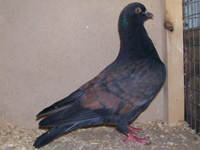 |
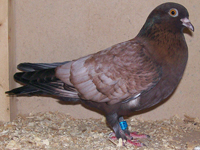 |
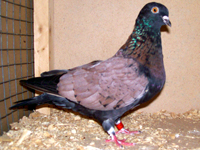 |
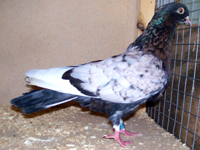 |
According to Quinn, the toy stencil bronze affects primarily coarse spread areas, but also has a pronounced effect on the transitional areas of the wing and tail, where a mixture of both clumped and spread pigment exists. The blue and smooth areas are little influenced. The toy stencil bronze differs from all other forms, in that it will stamp out the masked pattern in a spread pigeon. The depigmentation of coarse spread areas to white in a spread pigeon is a unique problem for us and we still have no clue how the bronze of TS bleaches into white in time. The toy stencil rollers directly above were bred by James Turner, who has completed putting TS into his top quality performing rollers. By looking at these pictures you can see the degree of bronzing and how it bleaches out when all the TS genes are present at homozygous state.
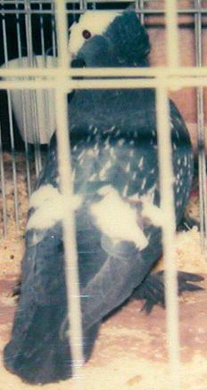 The
bronze phenotypes mentioned above are all very poorly characterized
because we simply
do not know
whole lot about the inheritance of all the bronzes, and many of us
are confusing bronze
phenotypes with each other. Although bronze phenotypes are very common
in domesticated pigeon breeds, and few studies about their inheritance
have been conducted in the past, we still do not know many things
about them. In fact, the confusion is so massive, it would
take huge
amounts of work to sort them out. The reason for the confusion on
this issue is we do not understand exactly what bronze is and how
they all behave as individuals. For instance there are at least three
or
four different mutants that are all being called kite among the pigeon
breeders, but if you look at them closely, there are obvious differences
in where the bronze happens and how much bronze is produced. These
are easy to confuse as all the things called kite in the hobby are
dominants. In reality, kite is supposed to bronze only the trailing
side of the
flight
feather and not bronze in front of the rachis. Even the bars of the
toy stencil complex of genes are considered as bronze colors even
though no one has ever reported any data on the isolation of the
individual toy stencil genes and identified them. We can tell from
the color
that
bronze bars are due to part of toy stencil which could easily be
confused as the Modena Bronze. According to Dr. Cryberg,
the Modena bronze genes
do not ever give that bronze color produced by one of the toy stencil
genes, nor do they give the same coverage of bronze when the bird
is hetero for them.
The
bronze phenotypes mentioned above are all very poorly characterized
because we simply
do not know
whole lot about the inheritance of all the bronzes, and many of us
are confusing bronze
phenotypes with each other. Although bronze phenotypes are very common
in domesticated pigeon breeds, and few studies about their inheritance
have been conducted in the past, we still do not know many things
about them. In fact, the confusion is so massive, it would
take huge
amounts of work to sort them out. The reason for the confusion on
this issue is we do not understand exactly what bronze is and how
they all behave as individuals. For instance there are at least three
or
four different mutants that are all being called kite among the pigeon
breeders, but if you look at them closely, there are obvious differences
in where the bronze happens and how much bronze is produced. These
are easy to confuse as all the things called kite in the hobby are
dominants. In reality, kite is supposed to bronze only the trailing
side of the
flight
feather and not bronze in front of the rachis. Even the bars of the
toy stencil complex of genes are considered as bronze colors even
though no one has ever reported any data on the isolation of the
individual toy stencil genes and identified them. We can tell from
the color
that
bronze bars are due to part of toy stencil which could easily be
confused as the Modena Bronze. According to Dr. Cryberg,
the Modena bronze genes
do not ever give that bronze color produced by one of the toy stencil
genes, nor do they give the same coverage of bronze when the bird
is hetero for them.
In addition, it is interesting that anecdotal reports from the bronze breeders suggest that bronze will not show in the sooty phenotypes. Although this might be true for some bronzes, Robert Mangile, who has extensive experience breeding toy stencil and frill stencil says sooty masking the bronze is not totally accurate. “Toy Stencil does express itself in 'sooty,' not sure about all of the bronzes, though. I've held the idea that toy stencil gives the best 'white' expression in sooty birds due to its following the pigment in the sooty areas. The fact that one does not see the typical 'sooty' markings in the wings coverts and neck does not mean that sooty is absent in that particular bird,” says Mr. Mangile (private communication). The Toy Stencil picture expressing the sooty plumage on the left is provided by Robert Mangile. The picture was taken at the Lincoln, Nebraska National Pigeon Show in 1983. It should be noted that the pattern of the bird is actually bar with white sooty markings. Pigeon breeders are also convinced that the presence of a bronze suppresses the effect of smoky, but we do not know which bronze they are talking about, and once again no data have been presented to support this claim.
Axel Sell states, "the analysis of bronze and the relationship between the different types of bronze is not yet finished. The matter is complicated by the fact that the different types vary in their expression and some of them might also occur together in one bird. A help in separating types is the fact that some of them affect different parts of the plumage. Some of them affect the breast, others the pattern only, one only the flight and tail tips. The listing of different types of bronze as one group does not mean that they should be regarded as allelic" (Breeding and inheritance in pigeons, p. 104). I completely agree with Dr. Sell. Pigeon fanciers have been calling phenotypes with a rusty appearance “bronze” or “kite.” Connecting these phenotypes to breeds the way Quinn once suggested seems easier, at first--but we are so accustomed to descriptive names like Modena bronze that we don’t realize that the bronze/kite found in one breed (Modena) will always be named the same (Modena bronze) in every other breed. In addition, majority of the bronze phenotypes are a ghastly mess. Perhaps the easiest to sort out are things that look like and are being called kite in the hobby; since most of the kites are dominants they would be easier to isolate. It is possible that all these kites are alleles, and it is equally possible that none of them are alleles. There are many versions of bronzes found in many different breeds, and isolating them would be even harder than the inheritance of kite since many bronzes produced by combinations of genes. The only sure thing about bronze phenotypes is that pigeon breeders are fascinated by them even though they know very little on how to manage them. Pigeon breeders also enjoy discussing bronze phenotypes perhaps because everyone is right about what they experience.
References:
1. Albertsen, F.
D. Possible Genetic Effects in “Ribbontail” Lebanons.
2. Cryberg, R. PhD.
(2009) Modena Bronze. Retrieved Aug.
20, 2012, from http://www.angelfire.com/ga/huntleyloft/modena_bronze.html
3. Cryberg, R. PhD.
Private communication.
4. Hollander, W. F. (1983).
Origins And Excursions In Pigeon Genetics: A Compilation. Burrton, Kan.: The
Ink Spot. Page 115
5. E.
Hasse, S. Ito, A. Sell, and K. Wakamatsu. (1992). Melanin Concentrations in
Feathers from Wild and Domestic Pigeons, Journal of Heredity.
6.
Horlachers, W. R. (1929).
Studies On Inheritance in Pigeons. VII. Inheretance of Red and Black Color Patterns
in Pigeons, The Agricultural and Mechanical
College of Texas, College Station, Texas.
7. Kral, L. Private
communication.
8. Levi, W. (1977). The Pigeon.
Sumter, S.C.: Levi Publishing Co, Inc. ISBN 0-85390-013-2.
9. Quinn, J. W.
(1971). The Pigeon Breeder’s
Notebook. QB&Q Publishing. Pages 75-80
10. Mangile,
R. J. Private communication.
11. Sale, G. Private
communication.
12. Sell, A. PhD. (1994). Breeding and inheritance in pigeons.
Hengersberg: Schober, Print. Pages 104-117
13.
Sell, A. PhD. (2011). Gimpeltaubenbronze
(Archangel Bronze). Retrieved Sept.
12, 2012, from http://www.taubensell.de/gimpeltauben_teil1.htm
14.
Sell, A. PhD. Private communication.
15. Turner, J. Private communication.
Copyright September,
2012 by Arif Mümtaz.